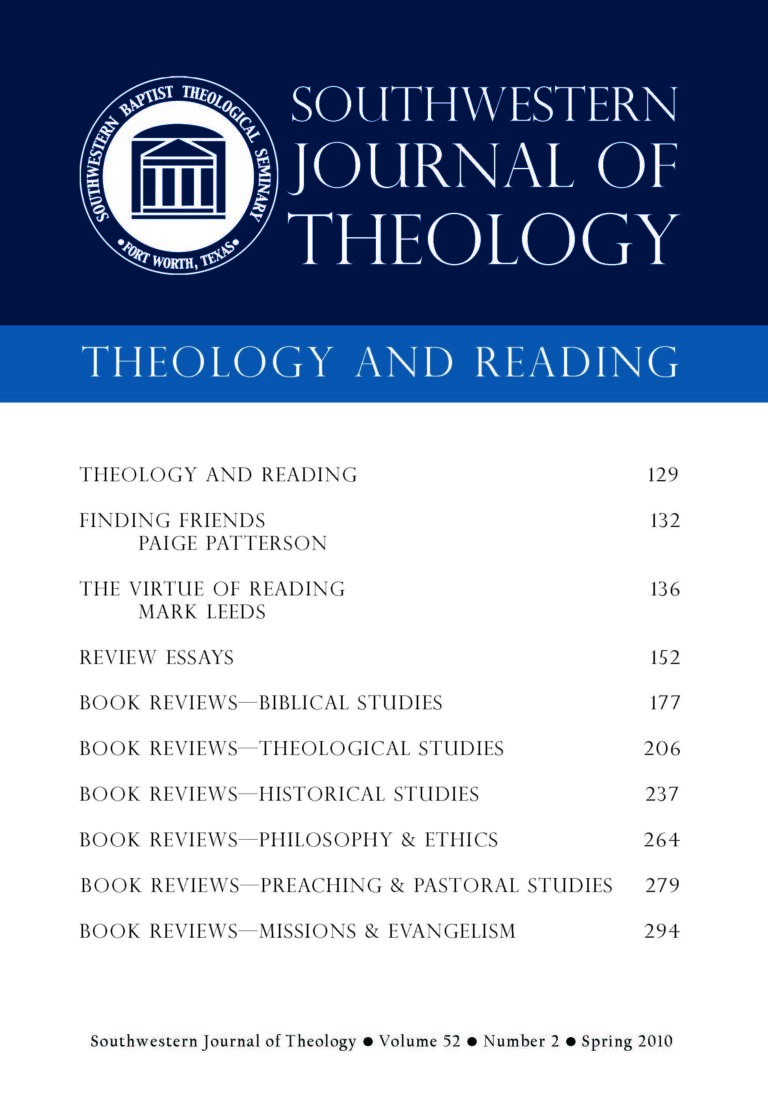
Theology and Reading
Southwestern Journal of Theology
Volume 52, No. 2 – Spring 2010
Managing Editor: Malcolm B. Yarnell III
Jeannine K. Brown. Grand Rapids: Baker Academic, 2007. 315 pages. Softcover, $24.99.
Believers often speak of the Bible as God’s Word to His people. In Scripture as Communication, Jeannine Brown offers a reflection on the implications of this affirmation and argues that the nature of the biblical text should determine the method used in its interpretation. Her choice of hermeneutical model follows directly from the conviction that “engaging in and interpreting communication is at the heart of what we are doing when we read the Bible” (13). Thus, Brown believes a communicative model of biblical interpretation best accounts for the “implicitly relational idea of the biblical text as communication” and “does justice to the dialogical nature of interpretation and contextualization” (15). According to Brown, this model enables “a holistic approach” to discerning textual meaning that attends to the diverse ways in which God speaks through Scripture (16).
A clear strength of this volume is the way Brown structures the content of her book and develops the various elements of her interpretive method. In part one, Brown devotes the first two chapters to delineating a communication model of hermeneutics and defining the terms involved in this discussion. The rest of this major section elaborates and develops what she outlines in the first two chapters. In part two, Brown’s move from theory to practice does not stray from the theoretical framework developed in part one. In her survey of theoretical models and interpretive strategies, she selects and highlights elements of these that contribute to a model of meaning rooted in communication. The issues of genre, language, social and literary context, and ultimately contextualization are each discussed in relation to the notion that the purpose of Scripture is to communicate. In this sense, each section in the book is intricately related to the broad thesis Brown develops.
Another notable strength is the keen attention given to illustrations. Indeed, her text is rife with brief case studies, pithy anecdotes, and extended illustrations, both in examples of biblical interpretation and in explanation of theoretical concepts. Valuing the “gift of definitional clarity” (19–20), Brown defines the terms that would be unfamiliar to a beginning hermeneutics student as they are introduced. While seeking to explain introductory hermeneutical issues, Brown also integrates and evaluates a wide range of scholarship including established works in the field (e.g., Gadamer, Ricoeur, Thisleton, Vanhoozer), though she seems to favor contemporary authors sympathetic to her approach. This combination of illustration and interaction broadens this volume’s readership and renders it valuable to the novice as well as veteran in the hermeneutical conversation.
Brown is also careful to highlight the benefit of adopting a communication model of meaning. This model avoids overemphasizing either the role of the author, text, or reader in the interpretive task but seeks a healthy tension between the three in the process of communication. Following the tradition of E.D. Hirsch and others, though not without critical evaluation, Brown maintains focus on the author’s intended meaning as evidenced in the text. A communication model also emphasizes the way an author’s textual meaning actively engages the reader. Rather than being a static object of study, the text is addressed to the reader and thus demands a fitting response. The model Brown advocates also furthers the discussion regarding the propositional versus personal character of Scripture. According to Brown, the multifaceted nature of the utterance meaning found in Scripture’s communicative action necessitates that interpreters affirm both of these elements.
Those who are wary of various features of the philosophy of language will remain suspicious of Brown’s assimilation and engagement with the contours of speech-act theory and relevance theory of language. Much of Brown’s conceptual framework depends on current discussions about the nature of communication and language. However, the contribution of Brown’s work involves the justification and defense of these elements as useful tools within a model of meaning and within the pursuit of a deeper understanding of the nature of the biblical text. Additionally, those who hold that the contextual information provided in Scripture itself is sufficient for interpretation will perhaps find Brown’s emphasis on the historical reconstruction of the social world of the biblical writers less than helpful. Forming a large part of the reason for this emphasis is relevance theory’s concern for discerning “contextual assumptions shared between the author and the original recipients” (190). One might wonder, though, whether the biblical writers, as competent authors, recognized and kept this communicative issue in mind as they wrote their texts for a broad audience. Further, it could be argued that the prevailing textual context for the New Testament authors was the narrative world of the Old Testament.
Though she includes an extensive bibliography and a subject and Scripture index, the appendices are surprisingly underdeveloped. The guidelines she provides in appendix A are helpful, but she is admittedly painting in “broad strokes” (275). Further, the appendixes on historical criticism (B), parallelism in Hebrew poetry (C), following an author’s flow of thought in an epistle (D), and how to go about topical studies (E) give only a cursory treatment of these topics. Those who accept her model for interpretation would have benefited from further developed excursus in these appendices.
In the end, this volume will not disappoint those seeking a readily accessible introduction to basic hermeneutical issues. The concerns noted here aside, Brown achieves her task of equipping the willing student to begin thinking of and responding to “Scripture as communication.”





